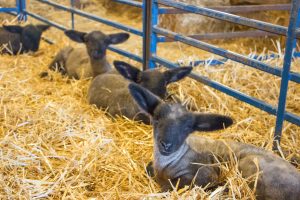
ASHLAND, Ohio — What makes the ideal club lamb? That depends on who you ask.
Mike Stitzlein has been chasing the crazy trends of the show lamb industry for the past 30 years.
“We tend to pick the extremes,” he said, referring to traits such as larger boned, muscular lambs and the current trend of leaving fuzz on the legs to make the lamb appear more stout.
“As much as we chase those trends, it’s important to remember there’s a production end of it,” he said. For Stitzlein, he is looking for a balance of muscle and frame.
“Ideally, we are trying to choose a product to go to market,” he said. “It scares me, sometimes, that the show ring gets too far away from that.”

History
Stitzlein Club Lambs started out as Mike’s FFA project. His grandparents had a small dairy farm at the time and his grandfather always had a few sheep as “lawn mowers.”
Stitzlein Club Lambs
797 County Road 1754
Ashland, Ohio
419-289-9520
mikestitzlein@gmail.com
“Back then, you had a few of everything,” said Stitzlein. Mike had shown a couple of those sheep at the Loudonville Street Fair before joining FFA in high school and starting his own small flock.
“Dad and I bought four Suffolk ewes,” he said. “Then it got out of hand.”
When he graduated high school in the mid-80s, he decided he could sell his lambs to local 4-H’ers who needed a project. After graduating from Ohio State University, in 1990, raising sheep became a full-time job.
“I really thought when I got out of college I would have a full-time job and raise sheep on the side,” he said.
After interviewing a couple places, he determined the sheep were making him more money than the jobs he was considering. He moved onto his grandparents’ farm and the small dairy was converted to a sheep operation.

Farming
Today, Stitzlein farms with his brother, Bruce, and Bruce’s children, Jacob and Jeff. The main farm is 117 acres, an additional 25 acres is rented, and Mike owns an additional 17 acres.
The Stitzleins are able to grow all their own hay and corn, and ewes graze on pasture throughout the summer. Each year, they lamb 250 ewes, sell some as club lambs, some as breeding stock and take some to the Mount Hope auction.
“We’ve started shifting more toward breeding stock,” said Mike. Stitzlein said they are able to sell a great deal of their stock online through his website and at local and national sales.

Young shepherds
Stitzlein said he enjoys any opportunity he can to help the next generation and the sheep industry as a whole. And his efforts have not gone unnoticed.
In April, Stitzlein was inducted into the Animal Sciences Hall of Fame at Ohio State University. Each year, he donates the use of his rams for Ohio State’s flock and assists the university’s judging teams by letting them come to the farm and practice with his flock.
While attending Ohio State himself, he had the opportunity to work at the sheep barn for three years and considers Ron Gunther, shepherd at the time, one of his biggest mentors.
“I had sheep growing up, but I was still pretty green. I learned a tremendous amount (from him).”
Stitzlein works to help aspiring young shepherds and encourage them to stay in the industry, even past the 4-H years.

The ring
Stitzlein has had the opportunity to judge sheep shows across the country and says, “it’s tough.”
For him, the ideal market lamb exhibits that balance of muscle and frame. He is looking for muscle, fat or conditioning and the lamb’s structure — how they carry that muscle and fat. “The animal still has to move,” he said.
“(Judging) helps as a breeder to see sheep across the country,” he added. “I look at structural things that work well for the overall sheep’s health.”
He said getting carried away and selecting too much against nature can lead to challenges with breeding.

Eat lamb
Stitzlein said he wishes more youth would taste lamb.
“What bothers me most is how many kids have shown a lamb and not eaten it. We want to promote our product,” he said.
“It’s fun to do the show thing, but let’s not get away from the industry,” he said. “(The sheep industry) is a small industry as a whole.”










